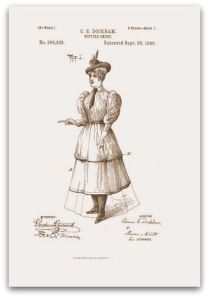Since March is Women’s History Month, let’s take a spin backwards in time to see what Staten Island women were up to in, say, 1895.
One industrious Staten Island woman seems to have been very taken with the latest craze: bicycles. Before the 1890’s, bicycle technology wasn’t very advanced, so they were sort of a novelty item. But then vast improvements in design made them sufficiently comfortable and safe for everyone to ride them – particularly and importantly, women. Before this, bicycles had belonged to that class of things that were reserved for men, like football, and cigars, and balancing the checking account.
Then instantly, bicycles became widely, hugely, insanely popular in America, like no-doc mortgages in the 2000s, but with a happier ending. Excitement was palpable. Vast sums were spent. In Dayton, Ohio, Orville and Wilbur Wright were churning them out endlessly. Bicycle societies sprang up everywhere. There was fevered speculation that one day, children would even ride bicycles to school.
The first bicycles on Staten Island were sold from Nicholas Bennett’s general store near Fort Wadsworth in 1896, and today, Bennett’s Bicycles is still in business on Jewett Avenue, where the fifth generation of Bennetts still run the oldest bike shop in New York City.
But back to our industrious woman. In a time when women did not have the right to vote, the suddenly accessible bicycle was a revelation, and an amazingly important factor in the nascent women’s suffrage movement. Bicycles got women out of the house and gave them a sense of mobility and autonomy they’d never known. No less a personage than Susan B. Anthony herself said,
Let me tell you what I think of bicycling. I think it has done more to emancipate women than anything else in the world. It gives women a feeling of freedom and self-reliance. I stand and rejoice every time I see a woman ride by on a wheel…the picture of free, untrammeled womanhood.
Yeah, that was awesome. Except for the part with the billowing skirts and corsets. Here enters our heroine, Mrs. Clarissa Ellen Dockham, of Tompkinsville, Staten Island, who on Jul 23, 1895 applied for U.S. Patent #556881 for the Bicycle Skirt. “My invention…has for its object to produce a combination garment which may be adjusted for convenient use when bicycling or which may be worn for ordinary street use.” Clarissa had figured out how a woman could, at will, transform her floor-length skirt into “bicycle-bloomers” and then back again, by means of a “forked or bifurcated skirt-lifter.”
No, don’t go there… Clarissa was spot on with the Rational Dress Society, which objected to:
fashion…that either deforms the figure, impedes the movement of the body, or in any way tends to injure the health. It protests against the wearing of tightly fitted corsets, of high-heeled or narrow toed boots and shoes; of heavily weighted skirts, as rendering healthy exercise almost impossible.
Yes. Now if we could just do something about Spanx. But I digress.
You would not think it so, but the increased mobility and the freedom and the bloomers turned out be positively scandalous and caused a whole heap of trouble in some quarters. There was great consternation that upon a bicycle, a woman could injure certain fair body parts, to her ultimate ruin. It was felt that the Orderly Domesticity of The Home would be greatly insulted if women could roam the streets at will, and that without a watchful husband nearby, females might fall prey to a lessening of their morals, thus bringing about the fall of civilization.
They did not yet have cable.
Perhaps Mr. Dockham was embarrassed and put his foot down, or maybe Clarissa was just too out there even for other women. Because the following year she filed another patent application. This one was a riff on the previous design, and it did away with the “skirt-lifters,” combining a skirt with built-in “drawers” in one adjustable garment.
“It will be evident,” Clarissa wrote, “that the skirt may be put on over the head and the drawers afterward buttoned, and it being remembered that women are averse to garments which do not go on over the head, the advantage of a trousers garment which can be put on over the head becomes at once apparent.”
The government of the United States agreed, and granted her Patent #568339.
I’ll just let that sink in for a minute.
Sad to say that’s all I know, except that the New York Daily Tribune reported on February 19, 1907, that “a dwelling house, No. 34 Central in Tompkinsville, formerly the property of the late Mrs.Clarissa Dockham, has been sold under foreclosure proceedings.” It had been a boarding house for some time, and was purchased by Otto W. Thomen of Grymes Hill for $16,500.
Let’s hope Clarissa had a great ride.

